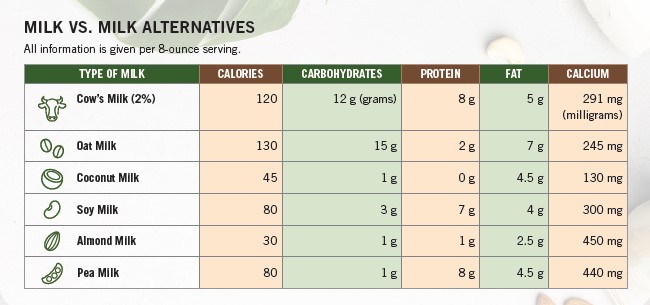Today, a wide range of milk types is available on supermarket shelves. If you’re looking for the “best” kind, however, you may be surprised to learn that there isn’t one.
“Each type of milk and milk alternative has its good qualities, and every person has different needs, goals, conditions and preferences,” explains Lindsay Whelan, MS, RDN, inpatient/ outpatient registered dietitian at Robert Wood Johnson University Hospital (RWJUH) Rahway. “There’s no one kind that’s best for everyone.”
For example, people with diabetes may want to consider low-carb milks, such as soy, almond or pea. A person with lactose intolerance or milk sensitivities might seek a nondairy milk alternative. A person with a nut allergy will avoid almond or coconut milk, and a vegan will want to consider coconut, soy, pea or almond milk.
“Individual tastes also play a role. You have to like what you’re consuming,” Whelan says. “When I’m working with a patient, we find foods they like and work them into their diet appropriately.”
No matter what type of milk you choose, however, select a lower-fat or unsweetened version, Whelan advises. “Some alternative milks add flavors or sweeteners to give them a better taste, but they may also be adding sugar and calories,” she says.
Rethinking Dairy
While each type of milk has its pros and cons, Whelan thinks that familiar old cow’s milk sometimes gets a bad rap, health-wise. “People talk about the fat in cow’s milk, but they don’t realize that alternatives are not necessarily going to provide you with the same nutrients, protein, vitamins and minerals,” she says. “A little bit of fat is good, such as in the fat in 1 or 2 percent milk, because the body needs it to absorb vitamin D. Whole milk is about 3.5 percent fat, and I wouldn’t recommend it for anyone except a baby from 1 to 2 years old, who needs it for proper growth, or for someone who is trying to gain weight.”
Concerns about the environmental impact of cow’s milk have played a large role in driving the recent explosion of milk alternatives, Whelan says. Research has shown that greenhouse gas emissions produced by dairy cows and their manure contribute to climate change. “However, milk alternatives have environmental impacts also,” she points out. Almond milk requires an enormous amount of water, and methods of producing coconut and soy milk are leading to destruction of rain forests. While the production of oat milk is more sustainable, “Oat milk is more expensive, has more calories than most alternatives and has very little protein,” Whelan notes. “One way or another, there’s a cost as well as a benefit to any milk choice we make.”
In the end, says Whelan, an informed choice is the best one. “Consider all the factors and your personal goals,” she says, “and drink the milk that’s best for you.”

To learn about outpatient dietitian services at RWJUH Rahway, call 732-499-6210.
